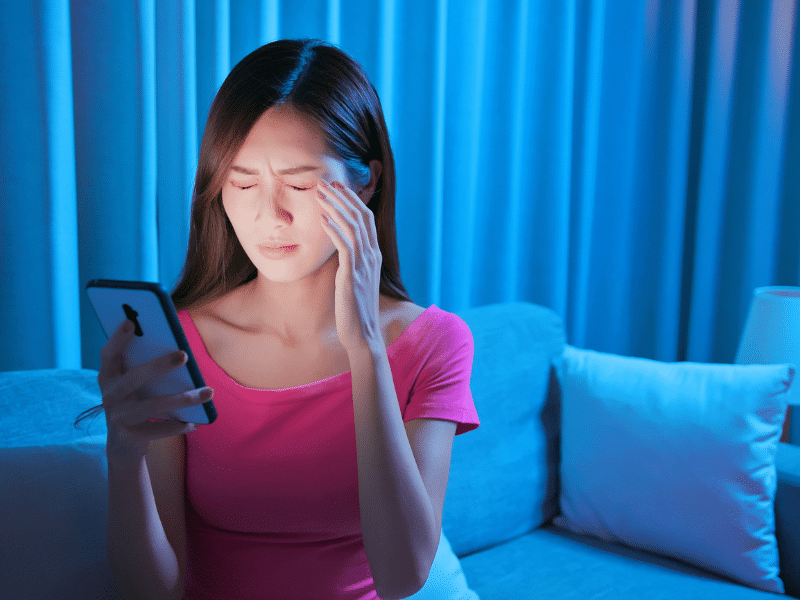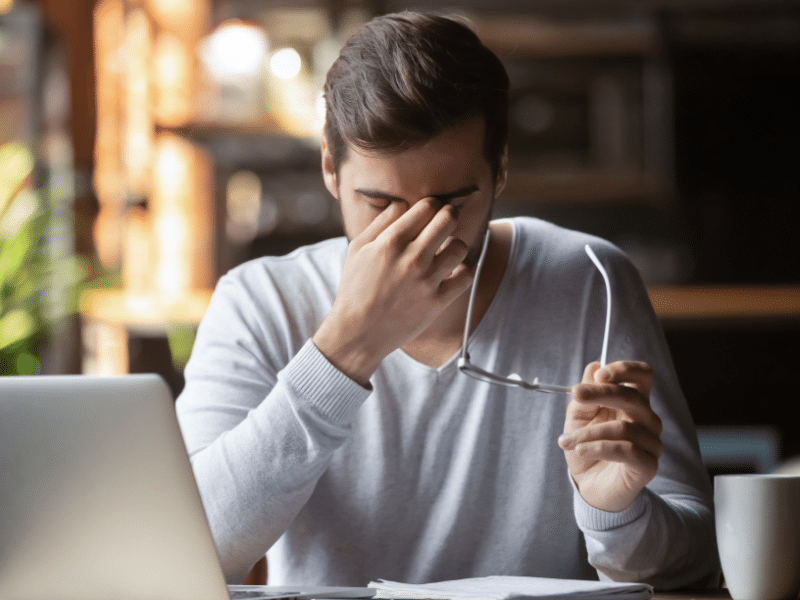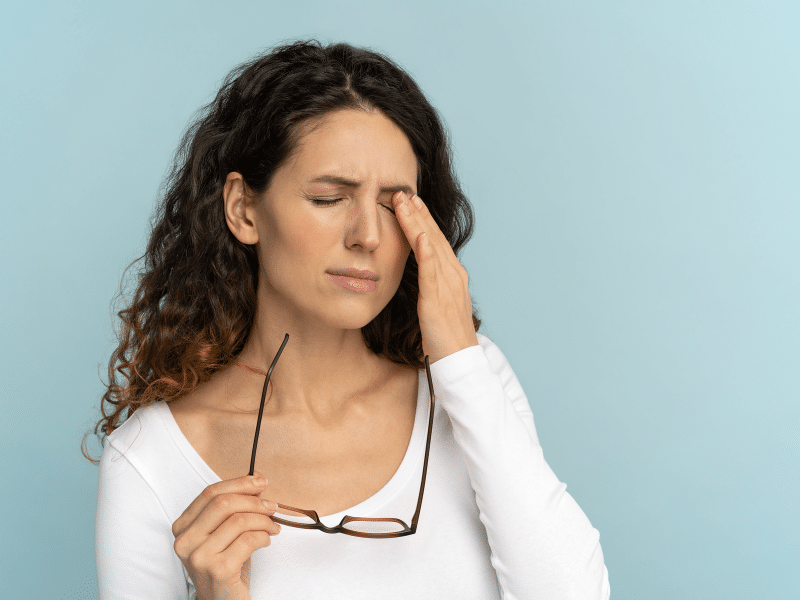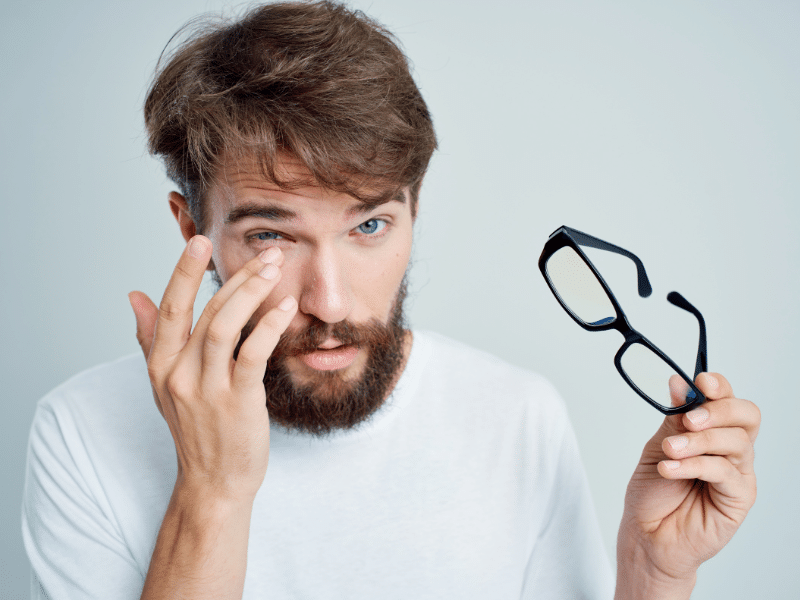
Eye strain is bothersome and can disrupt your daily life. In this article, I’ll talk about eye strain and what you can do to treat it.
Can Eye Strain Heal on Its Own?
Most of the time, eye strain will go away on its own.
In addition, eye strain is frequently manageable by making a few easy lifestyle changes (e.g., using digital devices less) and being mindful of the things that typically irritate the eyes.
However, eye strain can become more intense. In this case, you must consult a doctor.
How Long Does Eye Strain Take To Heal?

In general, mild cases of eye strain may resolve on their own with rest and other self-care measures within a few days. More severe cases of eye strain or eye strain that is caused by an underlying medical condition may take longer to heal and may require more intensive treatment.
To help your eyes recover from eye strain, you can try the following these eye health tips:
- Take frequent breaks from your digital device, big digital screens, and other close-up tasks.
- Blink frequently to keep your eyes moist.
- Use the 20-20-20 rule: for every 20 minutes, take a 20-second break and look at something 20 feet away.
- Avoid working in low light or harsh, bright light.
- Use eye drops to keep your eyes moist.
- Get plenty of sleep and try to reduce stress.
What Home Remedy Is Good for Eye Strain?

-
Lighting Adjustment
While watching television, keeping the room gently lit could be easier on your eyes.
When reading or working up close, try to place the source of light behind, directly onto the page or activity.
Furthermore, the use of natural light will always be the best option.
-
Limiting Screen Time
Limit yourself from using your digital device for eye strain relief.
This is extremely vital for children, who may not understand the link between extended periods of viewing, eye strain, and the need to rest their eyes on a frequent basis.
-
Taking a Break
When accomplishing work, take reading breaks and look away from the computer screen to rest your eyes. Taking a break once in a while working won’t hurt but can be beneficial, not to make the symptoms worse.
-
Choosing the Right Eyewear
If you’re wearing glasses or contact lenses and work with a computer, consider investing in computer-specific eyewear. Inquire with your doctor regarding lens coatings and tints, which may also be beneficial.
What Is Digital Eye Strain?

Digital eye strain is caused by the continuous use of tablets, computers, tablets, smartphones, e-readers, and other digital devices, which causes greater stress levels.
It also includes visual, musculoskeletal, and ocular issues caused by extended handheld digital devices and computer use. Eye strain or eye fatigue can also be caused by stress and weariness.
According to the National Eye Institute, digital eye strain is a common problem that can affect people of all ages, but it is more likely to occur in people who spend long periods of time using electronic screens or who have certain underlying vision issues, such as eye muscle imbalance or refractive errors.
Is Digital Eye Strain the Same As Computer Vision Syndrome?
Yes. Computer Vision Syndrome is generally referred to as visual fatigue or digital eye strain. It pertains to symptoms caused by constant working in front of various sorts of digital screens or other forms of computer screens.
CVS is a widespread problem among those with prolonged computer use. According to research, it affects 90% of users who spend over three hours a day staring at a computer screen.
Common Causes of Eye Strain

-
Computer and Digital Use
The main cause of eyestrain is prolonged usage of computers and other digital gadgets. The American Optometric Association calls this CVS or Computer Vision Syndrom, widely known as digital eyestrain. People who spend three hours or more a day looking have the biggest risk factors of developing this disorder.
-
Reading Without Resting the Eyes
Whether you’re reading on a screen or a book, if you’re doing so for an extended amount of time, you are going to cause some strain on your eyes. According to research, reading on a screen causes eye strain since you blink less frequently, which can also promote dry eyes.
-
Straining to See in Dim Light
Straining to see in very dim light or darkness may also suggest that you suffer from dry eye, an illness that occurs when the quality or quantity of your tears is insufficient to lubricate your eyes. This might cause harm to your eye’s surface. Prolonged screen usage and excessive reading can be the cause of this condition.
-
Stress or Fatigue
The “fight or flight” response of the body affects both eyes and the visual system, causing headaches and eye strain. Chronic stress can cause an increase in intraocular pressure, which increases the risk of glaucoma and optic nerve damage.
-
Being Exposed to Dry, Moving Air
Dry interior heat, dry outside air, cold temperatures, and dry outside all dehydrate the eye. These can lead to symptoms such as scratchy or burning feelings, puffiness, discomfort, impaired vision, and even watery eyes as your body attempts to adjust to the dryness.
-
Underlying Eye Condition
Existing medical conditions like uncorrected refractive errors are risk factors that increase the likelihood of eye strain. Your eyes function as an early alert system, notifying you whenever something happens that requires medical care.
-
Driving Long Distances and Doing tasks that Require Prolonged Focus
Writing, reading, and driving are all activities that require significant eye attention and can cause eye strain. This is especially true while driving since you rely on your sight by concentrating on other cars and street signs.
Symptoms of Eye Strain

-
Blurred Vision
The objects you view will not be crisp and clear if you have blurred vision. You may experience it in just one eye or both eyes. Everything you gaze at is blurry, while at other times, only a portion of your range of vision is obscured.
-
Headache
Tension headaches and migraines are the most prevalent forms of headaches. These basic forms of headaches are almost never related to visual problems. However, when a headache develops regularly after performing an activity that needs focused eyesight for a lengthy period of time, eyestrain is the most likely reason.
-
Sore, Watery, Itchy, and Tired Eyes
These types of visual irritations are also signs of eye strain. These can be distressing and upsetting, but they are curable. Just be sure to rest your eyes as often as possible.
However, to alleviate itchy eyes, you can use over-the-counter eye drops.
-
Light Sensitivity
It’s a typical symptom associated with various illnesses ranging from mild irritations to life-threatening medical situations. Visit your healthcare provider for severe cases.
Mild instances cause you to squint in a well-lit environment or when outside. Keeping out of direct sunlight and dimming the lighting indoors can help alleviate photophobia. Closing your eyes or keeping them covered using tinted, dark glasses can also help.
-
Dry Eyes
A dry eye is a prevalent condition in which your tears cannot adequately lubricate your eyes. Dry eye treatments, like lubricating eye drops or artificial tears, may make you feel more at ease. However, treatments like dietary adjustments may help elevate eye discomfort.
-
Sore Shoulders, Neck, or Back
People who spend extended periods of time doing activities such as writing, reading, scrolling on cellular phones, staring at a computer, or playing a video game are more prone to eye strain. These hobbies can cause eye strain, leading to back and neck pain. Poor posture due to excessive work may also be the culprit for this condition.
Botox for Eye Strain

Botox is injected into muscles to temporarily paralyse them. It’s most commonly used as a non-surgical wrinkle treatment. However, it can also treat conditions that cause muscle spasms or excessive sweating.
If you are experiencing eye strain, you may want to consider other treatments such as rest, eye drops, or glasses. It is also important to identify and address any underlying causes of your eye strain, such as prolonged use of screens or poor lighting.
However, Botox in London, UK, can help relieve eye strain pain. But before you use Botox for eye strain, make sure to consult your eye doctor.
In addition, Botox is FDA-approved for treating crossed eyes (strabismus). Crossed eyes may cause headaches, impaired vision, and strain on the eyes. It’s injected into one of your eyes’ muscles to calm the muscles and allows your eyesight to realign.
Non-Invasive Procedures for Eye Strain

LASIK (laser-assisted in situ keratomileusis) is a type of refractive surgery used to correct certain vision problems such as nearsightedness, farsightedness, and astigmatism.
The procedure works by reshaping the cornea using a laser. This helps to correct how the light is refracted or bent as it enters the eye, which can improve vision, reduce eye strain, and improve eye health.
Conclusion
Are you looking at Botox to relieve pain caused by eye strain or treat crossed eyes from one of the top skin clinics in London? Book a consultation with Dr. Julian De Silva now! Alternatively, you may visit us at 23 Harley St, London W1G 9QN, UK.

